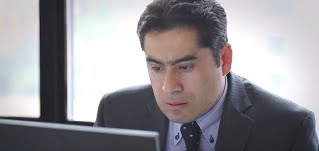BBVA Ambassadors: Mario Alexander Acuña, more than digitalization
Mario Alexander Acuña of BBVA Colombia likes to keep things simple, so much so that he made a series of recommendations to improve the Risk Committee. Little did he know that he would be put in charge of leading a key digitization process.

Up until a little less than a year ago, nobody aspired to be the secretary of the BBVA Colombia Risk Committee. Massive amounts of paper, managing agendas, coordinating presentations, and taking the minutes for the meetings made this a labor-intensive administrative job. However, it’s a critical function, given that key risk decisions are made at these meetings. One day, it was Mario Acuña’s turn to be secretary. That experience led him to make some suggestions that he thought would simplify the process.
At one presentation, he learned about a tool that could make it a lot easier to perform the secretary’s duties by streamlining all that information in a digital format. “We got in touch with the team that had developed the tool, but we realized that it wouldn’t meet all our needs,” he explains. However, Mario found a way to tweak the current solution: “We discussed the possibility of implementing it in Colombia, but with a few added features. That’s when we started to work with the people in Spain.”
The first challenge was to have the technical knowledge necessary to explain what he wanted the tool to do. “I’m not an expert in technology. It was a challenge because we had to tell the team in Spain what we wanted the tool to do.” Even so, Mario emphasized that “you don’t need to be an expert in technology to carry out a digital transformation process. To lead a project like this one, you only have to define the specifications to establish agile and effective processes. You also have to set the milestones. The developer has to know what you need as a user so he can produce the tool you’re looking for.”
"Sometimes, you can’t appreciate this work in the front office, because the users are the employees in the corporate center. However, these decisions come from the branches and have an impact on them.
It wasn’t an easy project. Transitioning people from an analog world to a digital environment has some thorny complications. “The hardest part is overcoming people’s resistance to change; you have to convince the organization to switch from a well-established process to a new one. Tools always have to be tweaked after they’re implemented. Furthermore, your workload doubles at first because during the testing phase you have to do both processes at the same time.”
He thinks it was worth the trouble. “In August, it will be one year since we started using the tool. Even though there are a lot of things we could improve, it was a hit and the final users really like it.”
Mario thinks we should simplify other processes. “The bank is focused on digitization. And it’s worth taking risks to push the organization in that direction. I think it’s important for all of us to make a contribution, no matter how small.”
"The hardest part is overcoming people’s resistance to change; you have to convince the organizationto switch from a well-established process to a new one.
Profile

Name: Mario Alexander Acuña
Position: Head of Policy – Risks department [BBVA Colombia]
Function: Contribute value
Hobby: Bike riding
Dream: To grow and create value for society
A PROJECT
The digitization of the Risk Committees wasn’t only a digital project in terms of implementing the tool itself.
For example, the team in Colombia collaborated with the development team in Spain digitally. “We only held one meeting and a videoconference,” Mario said. “The rest was done via email, chats, and telephone.” Mario says that was “one of the keys to the project’s success.” This method sharply reduced the development time: “In just eight months, we went from defining the specs to implementing and testing the tool.”
The users were also trained digitally. “When we started to show people how to use the tool, we realized that we could also take advantage of technology to train the employees, too. We used Google Hangouts so the analysts could receive their training at their workstations. That was great. We held training classes in groups of ten, with total interaction among the participants.”
They have even adapted the room where the committee meetings are held, “so the transactions can be projected on to a screen and each member can see it on their tablet or smartphone, or follow the presentation directly.”

CHALLENGE AND SOLUTION
When considering the project, Mario knew he needed two things: connectivity and online document management. “Before this, the analysts submitted their proposals through a shared drive. But that didn’t work very well, and someone could even delete one of the transactions by mistake. We also needed all the members of the committee to have access to the documents.” Up to that point, the only way to share the documents on the transactions submitted to the committee was on paper, which meant “making eight or nine copies for each transaction. The secretary also had to keep a copy.”
Now, all the proposals are loaded on the digital tool, which the committee members and the analysts can access. The tool also backs up the transactions, which means the secretary no longer has to do it.
This makes things easier for the Risk Committee, and it also has an indirect impact on the business. “Sometimes, you can’t appreciate this work in the front office, because the users are the employees in the corporate center,” Mario said. “However, these decisions come from the branches and have an impact on them. The decision-making process is much more agile now than it was before.”
Mario points out how serendipitous it is that a series of recommendations he made some time ago has ended up being his responsibility. This project is more than just a simple digitization process: it has turned out to be a “digital revolution” at BBVA Colombia.